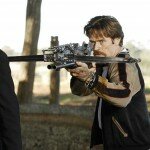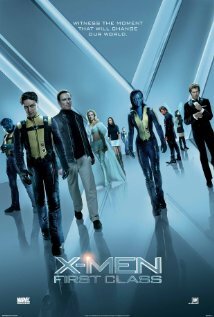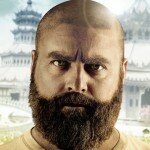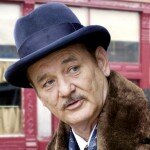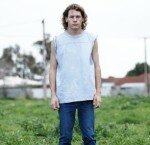Australian writers/directors Michael and Peter Spierig are the kindred masterminds behind the bloodthirsty new Vampire movie Daybreakers, their second feature to date after 2003s cult horror hit Undead. A co-production between Lionsgate in the US and Screen Australia, Daybreakers is very much a Hollywood film, boasting a cracking cast that includes Ethan Hawk, Willem Dafoe, Sam Neill, Claudia Karvan and Isabel Lucas.
Set in the near future where most of the population have been turned into vampires, Daybreakers follows scientist Edward Dalton (Hawke) as he researches a synthetic blood solution that would end the blood crisis gripping the world. It’s a refreshing and highly entertaining take on the old vampire mythology with some politically-minded brain matter mixed in amongst the copious amounts of blood and guts. You can read our full review here.
With Daybreakers opening in Australia last week, I spoke with the Spierig brothers over the phone about how the film has been affected by the recent surge of vampire movies, whether they fought like brothers during production and how they miraculously managed to stretch a $20 million budget into something that looks three times as much.
Cut Print Review: Ok, so fess up…whose idea was Daybreakers originally?
Peter: I have no idea! I think Michael might have mentioned something and I added to it? I honestly cannot remember. It really felt like it was the two of us coming up with the idea, so I really don’t know.
With this film it feels like you’ve done two things; honour the classic vampire that has been diluted in the last few years, but also bring some new ideas to that mythology.
Peter: Exactly. We wanted to kind of take the popular culture understanding of what a Vampire is — as in the rules and stuff — and respect that but offer something new. We’ve got some new additions to the vampire mythology and I hope those additions are logical and kind of make sense within that world. That was the goal; have the traditional aspect, but also add something new.
I think that the way the blood-deprived vampires mutate back into a bat creature is a great addition.
Peter: Yeah, we talked a lot about what would happen if they actually didn’t get blood and how that would affect them. And as you can see, it turns them into these horrible creatures!
Has the recent glut of vampire movies been good for business or bad for business?
Peter: It’s been good! It’s actually been very good; it has definitely drawn attention to our film than we might have had if there wasn’t the kind of Twilight and True Blood thing that’s out there at the moment. The reaction to our film has been really positive because people have been saying that it’s the antidote to those kind of softer vampire stories.
So was naming the lead vampire Edward, which obviously is the same in Twilight, pure coincidence or a deliberate backlash of sorts?
Peter: Well we shot Daybreakers in 2007, which is before they shot the first Twilight movie. So we had never even heard of Twilight at that point, so it was pure coincidental. One had nothing to do with the other, it just happened that way.
![2009_daybreakers_017[1] 2009 daybreakers 0171 e1265651736512 DAYBREAKERS Interview: Writers/Directors Michael and Peter Spierig](/wp-content/uploads/2009_daybreakers_0171-e1265651736512.jpg) Daybreakers co-director/co-writer Michael Spierig
Daybreakers co-director/co-writer Michael Spierig
I get the impression people who haven’t seen your first feature Undead might go into Daybreakers thinking it’s a self-serious horror movie. I mean, I laughed. I laughed a lot. And I’m pretty sure that was deliberate. It was deliberate, right?
Michael: [laughs] Of course that was deliberate!
Peter: Yeah, it was definitely our intention to make some of the most horrific moments over the top. And there are some things in the film that – I’m sure you’re aware – cause people to react incredibly strongly. But usually what happens is that there is this moment of absolute shock and then there’s laughter after that.
Yeah, we were all in fits during the most brutal scenes. It’s that kind of gore that is so over the top, you can’t help but laugh at the excessiveness.
Peter: Yeah, exactly. That was absolutely the intention.
Michael: It’s the best kind of gore!
![daybreakers_ver4[1] daybreakers ver41 240x350 DAYBREAKERS Interview: Writers/Directors Michael and Peter Spierig](/wp-content/uploads/daybreakers_ver41-240x350.jpg)
|
Michael, as a graphic designer, did you work closely with the design team at Lionsgate and Ignition Print with the marketing campaign?
Michael: Yeah we had a lot of say in designing the posters. I really like the poster campaign they’ve made. Unfortunately, we’re not getting it here in Australia, but the final one-sheets of the American posters which had all the individual vampires were fantastic.
The one where the vampire in a suit is hanging upside down is great, too.
Michael: Yeah, yeah they were great. I was a little bit concerned at first with our teaser poster because it looked a bit too much like 30 Days of Night. But these latest ones have been great, couldn’t be happier.
I get the impression that Australian’s won’t really see this as an Australian movie, which I thinks’ actually a good thing in terms of business. Do you feel like you’ve made an Australian movie, or a Hollywood movie in Australia?
Michael: I think we’ve made a Hollywood movie in Australia. With Australian money. And international money. [laughs]
Peter: I think what’s happened is we’ve made what looks like an American movie to people who aren’t really aware of the process and origin of the film. But you have to keep in mind that 90% of the people who worked on this project are Australian. So it’s definitely Australian made, that’s for sure. But when you work at the budget level that we were working at, you need to make if for the biggest audience in the world, and that’s Americans. And the truth is that there are not a lot of Aussies seeing Aussie movies. Just the way it is, sadly. So we wanted to make a film that would get as many people into the theatres as possible.
Yeah, the Australian film industry does tend to produce films that gain festival attention and win awards, but not make money. For that very reason, though, I think Screen Australia is now pushing towards funding more genre films than they have in recent years and I think Daybreakers is leading the charge. Would you agree?
Peter: Well I haven’t really noticed that they’ve pushed to genre pictures more, but I hope that Daybreakers is an example of what you can do with genre pictures. I mean, certainly they have funded a few genre pictures over the years, but I do think we could do more. There needs to be more!
Michael: The Loved Ones is coming out this year, which is a genre film. So yeah, they’re getting out there.
So how did Screen Australia get involved considering this was originally a Lionsgate production in the USA?
Peter: Yeah the first company to get involved was Lionsgate, and they had already put up a lot of money to make the film happen. We were pushing to get it shot in Australia, and I think Screen Australia and Screen Queensland saw the opportunity there. It was actually a really simple process — we didn’t have to convince them anything. They just wanted to get involved from the get go.
Michael: Peter and I were pretty adamant we wanted to shoot this Australia. We just said to them “look, we want to make it here.” We said that we wanted to use our guys, our Aussie crew, and we wanted to use our good friends at Weta Workshop in New Zealand. We just wanted to make it here. And as long as it’s financially viable for them, there was no problem.
Peter: It’s also very easy to convince Americans that we wanted to use a largely Australian cast because we have so many damn good actors here! And they realise that and they know that. Aussies have really taken over Hollywood.
So you didn’t have to max out your credit cards for this film like you did your last?
Michael: Oh, there’s no way I’m putting my credit card down for another film!
Michael and Peter: You do it once!
Peter: Yeah, you get your money back and never ever do it again. The fact that you make your money back on something you financed is so, so rare. It’s foolish to do that twice.
Well Daybreakers is hands down the most efficient use of a $20 million budget I’ve seen. I suspect a lot of that had to do with doing the visual effects yourself?
Peter: Yeah, absolutely. Michael and I did 350 of the 500 visual effects and that kept costs down quite dramatically. The other thing we did was reuse sets. Really though, it takes a lot of planning. I mean, we planned everything to the absolute finite detail. That helped maximise the time and all the money.
![2009_daybreakers_004[1] 2009 daybreakers 0041 e1265647174797 DAYBREAKERS Interview: Writers/Directors Michael and Peter Spierig](/wp-content/uploads/2009_daybreakers_0041-e1265647174797.jpg)
Peter and Michael Spierig
Then there’s the incredible George Liddle doubling as both the Production Designer and Costume Designer…
Peter: Yeah he’s obviously extraordinary in his ability to maximise money, but he’s such an incredible artist too. You know, he’s really one of those guys who is able to fill the world with detail and give you a look that is pretty incredible. It’s really a combination of George and Ben Nott the cinematographer. Those two worked so closely together and came up with some very clever ways of cutting costs like building lighting into the sets, which made the shooting a lot quicker and more efficient. They’re very clever people.
If you had more money to work with, where would you have spent it?
Michael: If we had more money, I think we would have added another Subsider battle. You know, those bat creatures? We wanted to put something near the end and wanted to have a big battle with those guys.
Peter: And that was scripted! That was there literally until a couple weeks before we started shooting. But there’s only so much money and you have to let some things go, unfortunately, and that was one of the things that went.
You’ve got a great Australian cast involved, but I daresay the film is really selling on its lead Ethan Hawke. I can’t remember the last time he’s done a genre film, so how come he sprang to mind for the role of Edward?
Peter: Well we actually thought about Ethan from the get go. When writing the script we thought, ‘gee, wouldn’t it be good to get an Ethan Hawk-type in this role?’ What we meant by that was somebody who was intelligent, vulnerable and a leading man. You know, someone with those kinds of qualities.
Of course, we never actually expected to get Ethan Hawke. We sent the script out to him and he reacted really positively and wanted to meet with us. So we sat down with him and he came on board. And the moment he said that it legitimised the film. It changed people’s opinion of it and made it possible to go out to Willem [Dafoe] and Sam Neill and Claudia Karvan and so on.
So did you have a ‘plan B’ if Ethan didn’t sign on?
Peter: Yeah we had a long list of actors. You have to do that because the chances of getting your first choice are very, very rare. So we really lucked out. Just about every single one of our first choices said “yes”!
Was it at all intimidating working with such experienced actors for the first time?
Peter: Well we certainly learnt a lot from those guys! Ethan and Claudia in particular are writers and directors and produces. Ethan’s even written a number of novels. So we definitely listen to their notes, and they definitely come with notes. Which is great! We really encourage that.
There are moments when it’s intimidating. Certainly at the beginning, but once we got on set and we were all in production it just felt like we were all trying to achieve the same goal and make the best film we could. You kind of forget they’re movie stars and focus on getting the film done on time and on budget.
![2009_daybreakers_002[1] 2009 daybreakers 0021 e1265651398842 DAYBREAKERS Interview: Writers/Directors Michael and Peter Spierig](/wp-content/uploads/2009_daybreakers_0021-e1265651398842.jpg)
Ethan Hawke, Claudia Karvan and Willem Dafoe in Daybreakers
Sharing the role of writer and director, there’s obviously a great deal of collaboration going on, so you’d have to be pretty well in sync with your ideas. That said, you’re also brothers, so surely you must have clashed heads from time to time!
Michael: [laughs]
Peter: Surprisingly, no we really didn’t. It’s really quite boring because we didn’t have many fights. I mean, we didn’t always agree on anything, but we’d just talk it through.
So what was something you didn’t agree on?
Peter: Well there’d be just a few elements in the script. Like, quite often we’d both get excited about things that weren’t really driving the narrative forward, such as little elements in the world. Cause you can get kind of lost in that vampire world pretty easily and you just have to stay focused on the narrative and characters. We did that quite often, and Michael would have to get me back on track or I’d have to get him back on track. That happened quite a bit.
Was there a defining moment during production when you fully realised the extent of what you were doing? That your movie was coming to life?
Peter: I think when the sets were going up on the Gold Coast that’s when it really started to feel like this was a big movie. It felt like the ‘real deal’, you know? Those ten years of struggling were starting to pay off.
Is there any chance we’ll see a sequel to Daybreakers? And would you guys be at the helm again?
Peter: I think we would do a sequel if the script was solid and had some interesting new ideas. I mean, we’ve been thinking about that and ideas have been floating around. It would also have to be the same cast; Ethan, Willem and Claudia would definitely have to be back.
But we’re working on a number of things at the moment. We’re always writing and there’s a script that we’re getting very close to finishing. It’s a science fiction film, but I can’t really talk much about that just yet. There’s a number of projects and they’re all getting closer to the point where we can actually talk about them, but not quite yet.
Your phones must be ringing constantly!
Peter: Yeah, it’s been great. We’ve had some pretty amazing meetings over the last couple of weeks! You know, there have been lots of good scripts coming our way. It feels like finally the opportunities are there and it’s just a matter now that we pick the right projects.
And do you plan to continue working here in Australia?
Peter: Ideally we’d like to keep things here. You know, at the end of the day we’ll go wherever we need to make the film we want to make. But if we had a choice, it would be to always make it here in Australia.
Peter and Michael, thank you for your time!
Michael and Peter: No problem!
—-
Daybreakers is now showing across Australia.
 Follow the author Anders Wotzke on Twitter.
Follow the author Anders Wotzke on Twitter.

